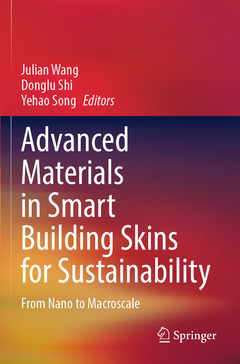Description
Advanced Materials in Smart Building Skins for Sustainability, 1st ed. 2023
From Nano to Macroscale
Coordinators: Wang Julian, Shi Donglu, Song Yehao
Language: English
Subject for Advanced Materials in Smart Building Skins for...:
Publication date: 10-2023
278 p. · 15.5x23.5 cm · Paperback
Publication date: 10-2022
278 p. · 15.5x23.5 cm · Hardback
Description
/li>Contents
/li>Biography
/li>Comment
/li>
Conventional building skins are constructed as static structures upon the typical design conditions in terms of external climate and internal occupant activities. This generates dissociation between the envelope structure and its environment. With the emerging advanced materials, such as chromic-based materials, spectrally selective coatings, and transparent photovoltaic, more dynamic and smarter building skins are now achievable and constructible.
This book updates readers on the key areas of smart building skins embodied in the novel advanced materials with unique structures and smart properties that enable multiple functions in energy efficiency, solar harvesting, and environmental greenness. It synergistically integrates the topics and knowledge of material design and experimental studies, theoretical analyses of building energy-saving mechanisms and solar energy utilization, and new design methodologies and processes taking advanced materials into account at different scales - from nano to the macroscale.
Dr. Julian Wang is an Associate Professor and Graduate Program Officer in the Department of Architectural Engineering at Pennsylvania State University, U.S. He also has affiliated appointment with the Department of Architecture and Materials Research Institute at Penn State. He received his Ph.D. from Texas A&M University in 2014 and Doctor of Engineering from Tianjin University, China in 2011. Before joining Penn State University, he has previously worked at the University of Cincinnati, Tsinghua University, and Lawrence Berkeley National Laboratory. He has been continuously involved in the research on sustainable building engineering and design, focusing on the fundamental topics of thermal and optical behaviors of building façades (especially windows and glazing systems) and the design integration of emerging functional materials for building energy efficiency, environmental sustainability, and indoor visual and thermal comfort, health, and well-being. He is also a recipient of the National Science Foundation CAREER Award and Illuminating Engineering Society Richard Kelly Award. He currently serves as Associate Editor of the journal of TAD (Technology, Architecture, and Design) published by Association of Collegiate Schools of Architecture and Taylor & Francis, and the Chairperson of the Solar Buildings Division in the American Solar Energy Society.
Dr. Donglu Shi is currently the Chair and Graduate Director of the Materials Science and Engineering Program in the Department of Mechanical and Materials Engineering, College of Engineering and Applied Science, University of Cincinnati, U.S. Dr. Shi’s research focuses on design and development of new nanostructures for novel properties and applications in energy and environment. These include National Science Foundation funded research in spectral selective solar harvest and energy generation via bio-inspired transparent thin films, photothermal-photovoltaic dual modality smart building skins, an
Demonstrates the importance of smart and dynamic building skins in in sustainable buildings
Provides the scientific basis for integration of nanoscale materials in building envelopes with enhanced performance
Illustrates engineering solution and design process incorporating advanced materials in applications of building skins

